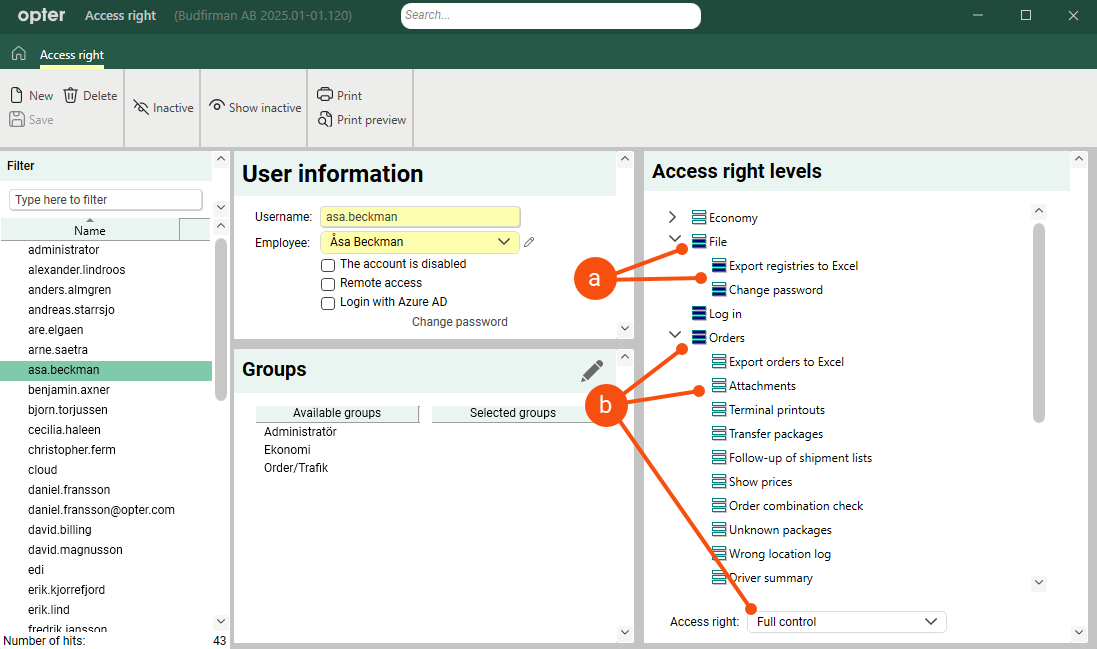Last updated: 2025-04-04
Setting access rights for users
In this article
When you create a user account, you also have to allocate some access rights to the user. If you do not give the user any access rights at all, they cannot log into Opter. The functions that the user does not have access to are dimmed in menus and windows.
Users can be given access rights in two different ways:
-
Create authorisation groups with access to a set of functions, which you then assign to users.
-
Manually authorise individual functions for individual users.
There are four levels of access. The level of authorisation that a user or authorisation group has for a particular function is shown by different filled icons.
-
, None: The user cannot open the function, and it is shown as dimmed in menus and windows.
-
, Read-only: The user can open and use the function, but not save any changes.
-
, Read Write: The user can add and change settings for the function.
-
, Full control: The user can delete, add and change settings for the function.
Creating access groups
An access group is a collection of access settings that can be linked to a user. By using access groups, you avoid having to configure the same access settings for different users with similar roles. Proceed as follows:
-
Click on Settings > Access rights.
-
Click on
 , next to Groups. The User groups window opens.
, next to Groups. The User groups window opens. -
Give the group a name. It is good if the name of the group reflects what the users in the group do in the system, for example “Finance”.
-
Right-click on a function and select an access level. If an access right is specified at a parent level, this access right applies to all the child functions below it (a).
It is also possible to mark a function and select an access right in the Access right drop-down list at the bottom of the window. If you do it at a parent level, the authorisation for the child functions on that menu will not apply, so you will also need to set the authorisation for the individual functions that users should have. In the image below, Full control has been set at the Orders level, but users are not authorised to access these child functions (b).

-
Click on
 to save all changes.
to save all changes.
Connecting access groups to users
-
Click on Settings > Access rights.
-
Double-click on the user whose access rights you want to change.
-
Double-click on the access group that you want the user to be part of, under Available groups, so that it is moved to Selected groups. You can also drag and drop access groups from one box to another.
-
Click on
 to save all changes.
to save all changes.
The user needs to restart Opter for the new access setting to take effect. It is not sufficient to simply log out.
You can connect multiple access groups to the same user, and also extend access rights for individual functions (see Allocating access rights to users for individual functions below). However, you cannot allocate a lower level of access to a particular function than the one set in the access group.
Allocating access rights to users for individual functions
If you do not want to connect the user to an access group, access rights can be allocated for individual functions.
If you have connected an access group to a user, you can extend the user’s access rights by giving the user access to functions that are not included in the access group, or allocating a higher level of access for a specific function.
This is how you allocate access rights to a user for individual functions:
-
Click on Settings > Access rights.
-
In the list on the left, select the user whose authorisation you want to change.
Access rights that are part of the access groups that are connected to the user are not displayed in the tree structure on the right. If the user is linked to an authorisation group and you want to see what permissions the user already has, open the authorisation group to which the user is linked by clicking
 next to Groups.
next to Groups. -
Right-click on a function and select an access level. If an access right is specified at a parent level, this access right applies to all the child functions below it (a).
It is also possible to mark a function and select an access right in the Access right drop-down list at the bottom of the window. If you do it at a parent level, the authorisation for the child functions on that menu will not apply, so you will also need to set the authorisation for the individual functions that users should have. In the image below, Full control has been set at the Orders level, but users are not authorised to access these child functions (b).

-
Click on
 to save all changes.
to save all changes.
The user needs to restart Opter for the new access setting to take effect. It is not sufficient to simply log out.
If there is a conflict between different access settings for a user, for example between the setting for an access group and the setting for the user, Opter always uses the highest of the specified access levels.